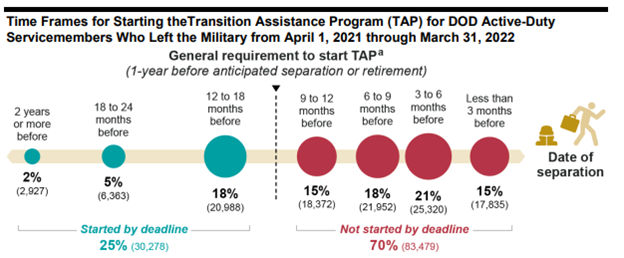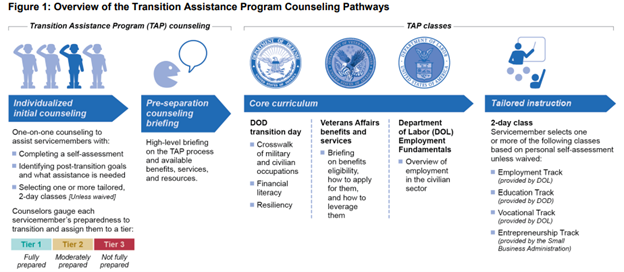The National Defense Authorization Act for FY 2019 made TAP classes mandatory for most service members departing the military. And while overall 90% of transitioning service members do attend TAP, a review by the GAO shows the DoD in general can do a better job as far as attendance in certain areas. The purpose of the review was to give the DoD a better understanding of the root causes that are causing the attendance issues that would in turn, help DoD officials craft and implement effective corrective actions and improve service members’ ability to benefit from the full range of transition resources available to them.
For instance, service members who have shown a need for maximum transition support are required to attend a 2-day class, but in their review, the GAO found that 25% did not attend the mandatory class. Another requirement of the program is that service members start TAP when more than a year out from separation. Yet, as the chart below shows, 70% did not start until they were less than one year out.

Data Courtesy of GAO
Counseling Pathways
To get a better understanding of the program, TAP is set up in what are known as counseling pathways. In these pathways, are five main areas:
- Self-assessment
- Individualized counseling
- Tier assignment
- Core curriculum
- Tailored Instruction
1. Self-assessment
This is an evaluation done by the separating service member on how well prepared they feel they are departing the military.
2. Individualized counseling
Once the self-assessment is complete, the individual sits down either face-to-face or virtually, with a counselor to discuss the self-assessment results and more about the preparation of leaving the military, along with a mandatory pre-separation briefing. The individualized counseling and pre-separation briefing should happen no later than one year from departure.
3. Tier assignment
Based on the self-assessment and individualized counseling, the service member is assigned to Tier 1, Tier 2 or Tier 3 – depending on how much more preparation they need before separation.
Tier 1 are those that are fully prepared and career-ready, requiring minimum transition support. Tier 2 are those individuals that are moderately prepared or career-ready, requiring some transition support. Tier 3 are those that are not fully prepared or career-ready, requiring maximum transition support.
4. Core curriculum
The core curriculum are a trio of classes over a three-day period that service members attend depending on their post-transition career goals. One is a DOD transition where a military-to-civilian crosswalk is discussed, along with financial literacy and resiliency. Another class is a benefit and services briefing by the Department of Veteran Affairs. The third class is an employment fundamentals briefing by the Department of Labor. which is basically an overview of the civilian labor market and workplace.

Chart courtesy of GAO
5. Tailored Instruction
This is a two-day class where a service member selects at least one of four “tracks” that are available depending on their tier assignment and what they feel the need. The four tracks and responsible agency for the instruction are:
- Employment – DOL
- Education – DOD
- Vocational – DOL
- Entrepreneurship – Business Administration
The Potential of TAP
TAP has shown to help service members prepare to leave military service if they complete the program tailored to their needs. But if they are skipping certain parts for whatever reasons, they leave ill-prepared at some level to meet the challenges of civilian life and work.
It will be interesting to look at some of the reasons why service members are skipping classes and break down some of the data by military branch to get a better idea of how well each branch administers their TAP policies.




